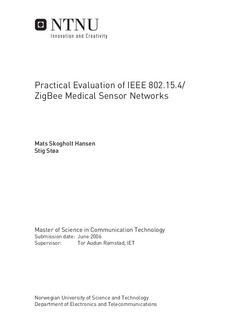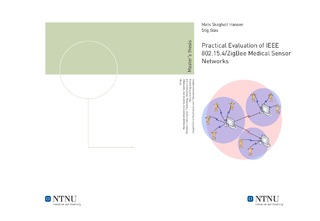| dc.description.abstract | In clinical diagnostics and treatment of patients, several biological parameters have to be measured and monitored. Typical physiological parameters important to the medical staff are blood gas, invasive blood pressures, pulse rate, temperature, electrocardiogram (ECG), etc. Introducing a wireless network system for the sensor data results in greater flexibility both for the patient and for the medical staff. Wireless connections make use of digital data, which along with other digital data may enable novel clinical as well as logistics applications. With the use of computers or PDA?s at other locations within the hospital, the medical staff would be able to monitor a patient regardless of his or her position as long as the he or she is connected to the network. The goal of this thesis is to investigate to what extent today?s of-the-shelf sensor network platforms is suitable for biomedical sensor networks, i.e. whether the requirements of medical data gathering are fulfilled.
IEEE 802.15.4 is a wireless standard that promises great flexibility, low cost, small hardware and low power consumption. It uses the publicly available 2.4 GHz ISM band for the radio and supports a data rate of 250 kbps. Several network structures are supported, and multi-hop transmissions promise great suppleness for dynamic networks. Medical sensor data as ECG and blood pressure operate with data rates of 3.2 kbps and 1.6 kbps respectively. With these rates, a theoretical upper limit for the network size in terms of number of nodes is found to be 47 nodes. Because the radio uses the increasingly crowded ISM band, coexistence issues have been investigated. The MICAz platform is used to test examine the possibilities of the IEEE 802.15.4 standard in a medical sensor scenario. Several simulation tools are assessed, and TrueTime is found to best suit the simulation needs for the intended experiments.
The experiments carried out examine the possibility of implementing a wireless sensor network for medical sensor data. Four MICAz nodes have been set up in different experiments. Simulations are used to expand the results to a grater number of nodes. The first experiment aims to reveal the range and radio reliability or indoor and outdoor environments. The indoor experiment experiences loss of the direct line of sight component, whereas the outdoor experiment always has a strong line of sight component. Further, an experiment is set up to find the packet loss under controlled conditions with varying packet sizes and possible resends on faulty transmissions. The same experiments meant to uncover the effect of interference from IEEE 802.11 stations. Another experiment employs the multi-hop capabilities of the nodes. Finally a simulation is used to investigate the network breakdown in terms of network density.
The signal strength experiment revealed fluctuating results for the indoor experiment. The outdoor experiment showed that the nodes have an effective working range of 15 meters with low packet loss and about 25 meters without breaking the connection. The packet loss test for different sized packets and resends exposed a timing issue in the network access of the nodes. By using the standard defined backoff system of the CSMA/CA algorithm, large packet losses were found. No significant increase in packet loss was uncovered in the interference experiments. By implementing a preemptive backoff scheme, far better results were achieved for both the interference free and interference case. The multi-hop experiment exposed another shortcoming of the hardware. Large number of packets in the network seem to saturate the micro controller on the motes, and very irregular results were experienced. The corresponding simulation showed no sign of network saturation. The breakdown test showed that with the data rates of the medical sensors used, up to 10 nodes can be deployed before the packet error rate passes 5%. For large packets the equivalent number is 20 because of better utilization of the network resources. By implementing a simple compression algorithm known as delta encoding, the capacity of the system was doubled without any added error probability.
There are still many unsolved and unaddressed issues regarding medical sensor networks with IEEE 802.15.4. The MICAz platform is to immature for heavy network operations like routing of large amounts of data. The full potential of IEEE 802.15.4 is yet to be investigated with the beacon mode. Energy and security issues have to be addressed together with QoS. All in all, the results from the experiments point in a negative direction, but with improvements to the platform and OS together with a thought-through adaptation of the standard, acceptable results may emerge.
IEEE 802.15.4 is a wireless standard that promises great flexibility, low cost, small hardware and low power consumption. It uses the publicly available 2.4 GHz ISM band for the radio and supports a data rate of 250 kbps. Several network structures are supported, and multi-hop transmissions promise great suppleness for dynamic networks. Medical sensor data as ECG and blood pressure operate with data rates of 3.2 kbps and 1.6 kbps respectively. With these rates, a theoretical upper limit for the network size in terms of number of nodes is found to be 47 nodes. Because the radio uses the increasingly crowded ISM band, coexistence issues have been investigated. The MICAz platform is used to test examine the possibilities of the IEEE 802.15.4 standard in a medical sensor scenario. Several simulation tools are assessed, and TrueTime is found to best suit the simulation needs for the intended experiments.
The experiments carried out examine the possibility of implementing a wireless sensor network for medical sensor data. Four MICAz nodes have been set up in different experiments. Simulations are used to expand the results to a grater number of nodes. The first experiment aims to reveal the range and radio reliability or indoor and outdoor environments. The indoor experiment experiences loss of the direct line of sight component, whereas the outdoor experiment always has a strong line of sight component. Further, an experiment is set up to find the packet loss under controlled conditions with varying packet sizes and possible resends on faulty transmissions. The same experiments meant to uncover the effect of interference from IEEE 802.11 stations. Another experiment employs the multi-hop capabilities of the nodes. Finally a simulation is used to investigate the network breakdown in terms of network density.
The signal strength experiment revealed fluctuating results for the indoor experiment. The outdoor experiment showed that the nodes have an effective working range of 15 meters with low packet loss and about 25 meters without breaking the connection. The packet loss test for different sized packets and resends exposed a timing issue in the network access of the nodes. By using the standard defined backoff system of the CSMA/CA algorithm, large packet losses were found. No significant increase in packet loss was uncovered in the interference experiments. By implementing a preemptive backoff scheme, far better results were achieved for both the interference free and interference case. The multi-hop experiment exposed another shortcoming of the hardware. Large number of packets in the network seem to saturate the micro controller on the motes, and very irregular results were experienced. The corresponding simulation showed no sign of network saturation. The breakdown test showed that with the data rates of the medical sensors used, up to 10 nodes can be deployed before the packet error rate passes 5%. For large packets the equivalent number is 20 because of better utilization of the network resources. By implementing a simple compression algorithm known as delta encoding, the capasity of the system was doubled without any added error probability.
There are still many unsolved and unaddressed issues regarding medical sensor networks with IEEE 802.15.4. The MICAz platform is to immature for heavy network operations like routing of large amounts of data. The full potential of IEEE 802.15.4 is yet to be investigated with the beacon mode. Energy and security issues have to be addressed together with QoS. All in all, the results from the experiments point in a negative direction, but with improvements to the platform and OS together with a thought-through adaptation of the standard, acceptable results may emerge. | |

